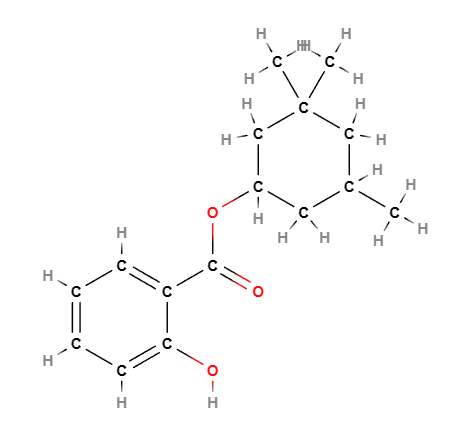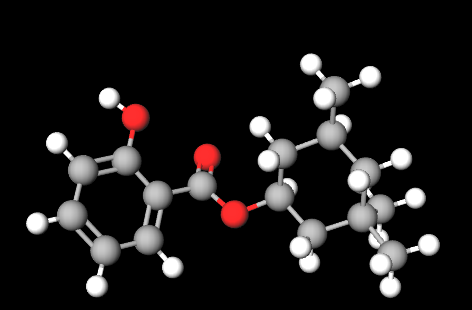| "Descrizione" by A_Partyns (12948 pt) | 2024-May-10 11:57 |
Homosalate is an ester derived from salicylic acid nd 3,3,5-trimethylcyclohexanol, a derivative of cyclohexanol It is used as a UV filter in sunscreen products.
Industrial Production Process
- Preparation of reagents. The two primary reagents are obtained: salicylic acid, an aromatic acid, and 3,3,5-trimethylcyclohexanol, an aliphatic alcohol.
- Esterification reaction. Salicylic acid and 3,3,5-trimethylcyclohexanol are combined in a reactor in the presence of an acid catalyst, like sulfuric acid, to produce the ester known as homosalate. The reaction occurs at an elevated temperature to improve efficiency.
- Water removal. The water formed during the reaction is removed by distillation to favor ester formation and prevent the reverse reaction.
- Neutralization. The excess acid catalyst is neutralized with a base, like sodium hydroxide, to stop the reaction.
- Filtration. The mixture is filtered to remove any solid byproducts and impurities.
- Final distillation. The product is purified via vacuum distillation to isolate and collect homosalate.
- Quality control. The final product is tested to verify its purity, stability, and compliance with standards.
What it is used for and where
Homosalate is an active ingredient used in cosmetic products as a chemical sunscreen filter to absorb UVB radiation. It helps protect the skin from sunburn and reduces UV damage. It is often combined with other UV filters in sunscreen creams and sun protection products to provide broader-spectrum protection.
Cosmetics - INCI Functions
It is a restricted ingredient as VI/3 a Relevant Item in the Annexes of the European Cosmetics Regulation 1223/2009. Substance or ingredient reported: Benzoic acid, 2-hydroxy-, 3,3,5-trimethylcyclohexyl ester / Homosalate
Product Type, body parts Face products with the exception of propellent spray products
Maximum concentration in ready for use preparation 7,34 %
Other From 1 January 2025 cosmetic products containing that substance and not complying with the conditions shall not be placed on the Union market. From 1 July 2025 cosmetic products containing that substance and not complying with the conditions shall not be made available on the Union market.
- Fragrance. It plays a very important role in the formulation of cosmetic products as it provides the possibility of enhancing, masking or adding fragrance to the final product, increasing its marketability. It is able to create a perceptible pleasant odour, masking a bad smell. The consumer always expects to find a pleasant or distinctive scent in a cosmetic product.
- UV absorber. It acts by intercepting ultraviolet light before it can cause damage by reducing its energy through dissipation and returning it to a lower energy state.
- UV filter. It is the defining ingredient in sun creams that can mitigate the sun's ultraviolet (UV) radiation, which is a high risk factor for the development of skin cancer, erythema and photo-ageing.
Safety
From 2025, the maximum permissible concentration in cosmetic products must not exceed 7.34% due to safety concerns for those who apply multiple UVF products (3).
 |  |
Molecular Formula C16H22O3
Molecular Weight 262.34 g/mol
CAS 118-56-9
UNII V06SV4M95S
EC Number 204-260-8
DTXSID1026241
Synonyms:
Homomenthyl salicylate
Coppertone
References_____________________________________________________________________
(1) Holt EL , Krokidi KM , Turner MAP , Mishra P , Zwier TS , Rodrigues NDN , Stavros VG . Insights into the photoprotection mechanism of the UV filter homosalate. Phys Chem Chem Phys. 2020 Jul 21;22(27):15509-15519. doi: 10.1039/d0cp02610g. Epub 2020 Jun 30. PMID: 32602867.
Abstract. Homosalate (HMS) is a salicylate molecule that is commonly included within commercial sunscreen formulations to provide protection from the adverse effects of ultraviolet (UV) radiation exposure. In the present work, the mechanisms by which HMS provides UV photoprotection are unravelled, using a multi-pronged approach involving a combination of time-resolved ultrafast laser spectroscopy in the gas-phase and in solution, laser-induced fluorescence, steady-state absorption spectroscopy, and computational methods. The unique combination of these techniques allow us to show that the enol tautomer of HMS undergoes ultrafast excited state intramolecular proton transfer (ESIPT) upon photoexcitation in the UVB (290-320 nm) region; once in the keto tautomer, the excess energy is predominantly dissipated non-radiatively. Sharp transitions are observed in the LIF spectrum at close-to-origin excitation energies, which points towards the potential presence of a second conformer that does not undergo ESIPT. These studies demonstrate that, overall, HMS exhibits mostly favourable photophysical characteristics of a UV filter for inclusion in sunscreen formulations.
(2) Matta MK, Florian J, Zusterzeel R, Pilli NR, Patel V, Volpe DA, Yang Y, Oh L, Bashaw E, Zineh I, Sanabria C, Kemp S, Godfrey A, Adah S, Coelho S, Wang J, Furlong LA, Ganley C, Michele T, Strauss DG. Effect of Sunscreen Application on Plasma Concentration of Sunscreen Active Ingredients: A Randomized Clinical Trial. JAMA. 2020 Jan 21;323(3):256-267. doi: 10.1001/jama.2019.20747.
Abstract. Importance: A prior pilot study demonstrated the systemic absorption of 4 sunscreen active ingredients; additional studies are needed to determine the systemic absorption of additional active ingredients and how quickly systemic exposure exceeds 0.5 ng/mL as recommended by the US Food and Drug Administration (FDA). Objective: To assess the systemic absorption and pharmacokinetics of the 6 active ingredients (avobenzone, oxybenzone, octocrylene, homosalate, octisalate, and octinoxate) in 4 sunscreen products under single- and maximal-use conditions....Conclusions and relevance: In this study conducted in a clinical pharmacology unit and examining sunscreen application among healthy participants, all 6 of the tested active ingredients administered in 4 different sunscreen formulations were systemically absorbed and had plasma concentrations that surpassed the FDA threshold for potentially waiving some of the additional safety studies for sunscreens. These findings do not indicate that individuals should refrain from the use of sunscreen. Trial registration: ClinicalTrials.gov Identifier: NCT03582215.
(3) Lukić J, Đurkić T, Onjia A. Dispersive liquid-liquid microextraction and Monte Carlo simulation of margin of safety for octocrylene, EHMC, 2ES, and homosalate in sunscreens. Biomed Chromatogr. 2023 Apr;37(4):e5590. doi: 10.1002/bmc.5590. Epub 2023 Feb 9. PMID: 36709999.
| Evaluate |

